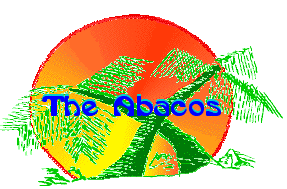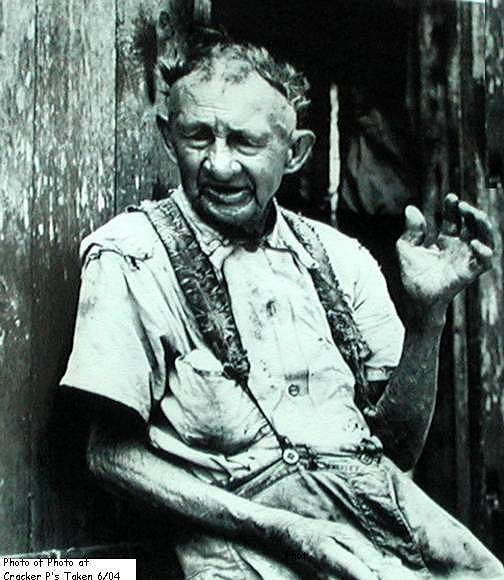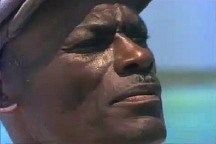This website is has been updated 4/17/19 with useful information for a first time visitor.
MARINE VHF RADIO:
A practical item that we always bring, admittedly a hold over from boating days, is a Marine VHF Walkie Talkie. It's fun and invaluable tool for use in making a dinner reservation, booking a golf cart or boat rental and even hailing a taxi in Marsh Harbour. Even listening to the island chit chat is fun. But most importantly, you'll be able to listen to the Cruisers Net.
THE CRUISERS NET:
In the Abacos there is what is known locally as "The Cruisers Net". It's an all volunteer radio broadcast on Marine VHF CH 68 every day at 8:15 AM. It was originally geared for the cruising yachtsman. It's been described as a combination CNN, Weather Channel, Entertainment Tonight, Discovery Channel, e-mail forwarding service and emergency broadcast system all wrapped up in one. Most rental boats include a VHF Radio.
It origionated by Patti & Bob Toler in 1992. Patti was the voice behind the mike and Bob the weatherman. Every morning starts with the weather at 8:15 and repeats at 9:00 complements of BarometerBob.com. followed by the announcements by the bars, restaurants, scuba folks, or anybody else with an item of interest for visitors and yachtsmen. Here you will find out where the barbecues are and where the bands are playing etc. Following that there is a check in period for new arrivals and a departure period to say your good byes and or recruit a buddy boat. There is even a question period for new folks like YOURSELF. One might ask "what is the treatment for sea lice" or where can I buy some unusual product.
The broadcast emanates from Marsh Harbour and is easily received on Man-O-War, Guana Cay, Elbow Cay (Hope Town), Regrettably reception is poor on Green Turtle (30 miles to the north).
*I've been using this old Standard Horizon HX150 VHF for years. And it uses AA Batteries in a pinch. It is the second item I pack after a flashlight when heading to Abaco. They can be purchased at marine supply stores in the states like West Marine. Radio Protocol has assigned CH 16 for hailing and calling. Once contact is made one switches to another channel. In the Bahamas (not the US) it is usually Channel 11 ,12, 13 ,14, 15, 68, 69. Hailing a Marsh Harbour Taxi is on CH 06. Don't use other channels unless suggested by the local party as others are assigned to Search & Rescue, Fire Department etc. etc.

|
|
COMMUNICATIONS:
Cell service is available, however check with your carrier for specifics. See Great iPhone Tip. The Bahamian area code (from the outside) is 242. Skipe works well when you know what you are doing. There is island wide WiFi in most areas, plus a plethora of hot spots and even internet cafés.
For details on a mobile WiFi account when in Abaco, check out, Out Island Internet or BahamasWiMax. Both cover from Green Turtle Cay to Little Harbour. Expanded full island wide coverage was planed for the near future and may not be working. Many resorts also offer an on premises computer terminal or WiFi for guests. Still with all this technology available, you'll be hard pressed to find a telephone or TV in a resort room. Oh, stay away from those "BLUE PAY TELEPHONES". They will take any credit card but hit you with an exorbitant charge! Finally, the Abacos are a place to disconnect and unwind but if you must bring your lap top, and need an excuse, this will do the trick. It's made for the Abacos and fun too.
TRAVEL:
PROVISIONING: For folks renting a home and or have cooking facilities, small grocery stores can be found on all the cays but variety is limited with produce generally poor. Still fresh baked bread and pastries are found along with local favorites like conch salad. Fish Markets seem to come and go on the Cays so ask around. The solution is shop in Marsh Harbour, The stores are larger, cheaper and some are close to stateside supermarkets like Maxwell's. Here, produce is fresher and there is a good selection of meat and the turn over is greater. Prices are closer to stateside, yet some items twice the price. The best prices we hear are at Abaco Grocery which is on your right just after you leave the airport by the nusery. Remember, resort villas will often offer frig with only a microwave for cooking. Keep that in mind.
MONEY: The Bahamian dollar is on par with the US dollar. Both are used interchangeably and you can request your change be in US as we do usually near the end of our trip. Some credit card companies tack on a "foreign transaction fee" (1-2%) for each charge.
POLARIZED is the magic word here in the Abacos . Get yourself a pair of Polarized Sunglasses if you don't already have them. They remove glare and reflection accentuating the turquoise, green and blue of the Abaco waters. And their through water penetration is amazing. If you are like myself and use glasses to read, consider a pair of polarized glasses with readers on the bottom and no magnification on the top, They're found at sporting goods departments. You might also want to consider a polarized filter on your camera.
FLYING TIPS:1. Book in Advance & Re-Confirm two weeks prior.
2. Use carry on luggage if you can, in case you have to change flights in a hurry.
3. Late arrivals can cause conflicts trying to catch the last ferry if traveling to Cays.
4. Connections via NASSAU can often result in missed connections via Bahamas Air and increase your odds of lost or late arriving "checked" luggage.
5. Get to your departing flight early, not to deal with lines, but to allow time for your passport number to clear with Homeland Security in the US. 6. Suggestion; If you have an early AM flight, you might want to consider a day in Marsh before your leave - Rent a car and do a little Big Island exploring. The Lofty Fig and Conch Inn allow one night booking.
|
|

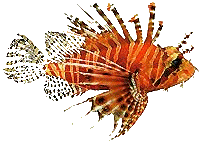
WATERBORN NUISANCES
PACIFIC LIONFISH: A decade ago, the reports of the Pacific Lionfish being spotted began. This non-indigenous, yet beautiful fish with poisonous spines now-a-days seems to be a permanent resident of the Bahamas. If you see one when snorkeling Don't Touch it! It wont bother you. To combat this menace to the indigenous fish populations, it has been suggested we eat them! Make them a trend, like Blackened Redfish or Chilean Sea Bass. The fish is quite tasty and already being served in restaurants in Nassau and Abaco. Caution must be used when filleting the fish and disposing of the dorsal spines. To help in reducing their population, The Green Turtle Club held the Abacos 1st Lionfish Derby. It was to become an annual event.
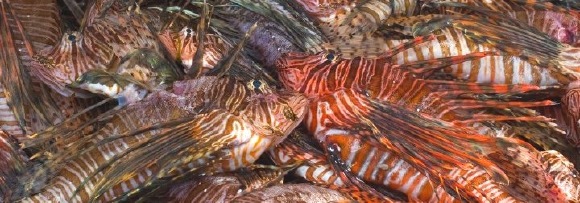
L i o n f i s h
The 1st Lionfish Derby went fantasticlly with 25 boats participating. These were all small boats in the 17 to 28 foot range. Catching was mostly by spear and believe it or not at the end of the day they had landed 1,408 fish! A few boats alone had over 70. And yes, four or five folks got poked by the fishes spines. It's painful, worse than a jellyfish and not fatal unless you are allergic to stings. Fortunately there were no serious problems and most were treated by squeezing the puncture area to remove excess venom then rinse with something acidic, Vinegar will do. Some claim urine will work but it's usually not acidic enough. Things you should know (See Video).

These are the little critters that cause the what you see on the following picture.
SEA LICE: Sea Lice - I have heard for years about Sea Lice in the Bahamas. It's routinely discussed on the Cruisers Net. It causes an itching / burning sensation that can ruin your vacation lasting for a week or more. They aren't actually lice but the the larvae of the thimble jellyfish which find their way under bathing suits and wet suits and become trapped against the skin and sting. Like I said, I've often heard of them but never had encountered any in my years of going to the Abacos, till recently when my wife did. Sven though we always dove or swam in the same areas, I was fine. She didn't come in contact with them until the day before we flew home and her rash wasn't as bad as the victims picture below. Still, she was still scratching a week later. Looking into the matter upon our return, I concluded that in order to avoid this, ones bathing suit especially woman's one piece suit and divers wet suits should be replaced by a dry one as soon as you come out of the water. Debbie's misfortune as it turned out was that she happened to wear a one piece bathing suit that day. An Abaco traveler who happened upon my website and saw this post contacted me. He is Clinical Chemist & Biology Instructor with a personal experience in sea lice. On top of that he has a cheap solution to the problem.
Find out what Gregory Rawling has to say on sea lice.

Baracuda
CIGUATERA, is a poisioning from eating certain fish. We hesitate mentioning this for fear of scaring folks away from eating seafood (fish) in the Abacos. We can state we know of no one personally or even a friend of a friend that contracted Ciguatera but it does exist here and there from time to time in the Abacos. Every now and then it is mentioned on an Abaco bulletin board. Simply put, Ciguatera is a neuropathic disorder. It is a unique type of food poisoning caused by the consumption of marine species that harbor natural toxins originating in certain tropical waters. In a nutshell it's likely to occur in bottom dwelling reef fish such as grouper and snapper while free swimming pelagic species or migratory fishery such as Dolphin (Mahi Mahi), Wahoo and Tuna pose little to no risk of the toxin. One fish that is known to be a risk is Baracuda weighing more than a couple pounds. Rather than go into great detail here, check out what a report by Clemson.edu has to say. It's all you need to know concise and straight forward.
|
|

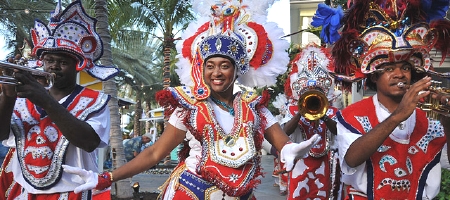
JUNKANOO is a Bahamian national festival and exists only here. It is a kaleidoscope of color and sound, the latter (origionally) being a blend of cow bells, goat skin drums and whistles accompanied sometimes by an array of brass instruments. Participants wear brilliantly colored costumes while dancing to the rhythm of the music. Originally the music was more primitive as compared to that of other countries music of "Carnival" IE: Calypso associated with Trinidad or Samba in Rio.
Junkanoo is not to be confused with "Carnival" which is celebrated in the Caribbean Islands, Brazil and Mardi Gras, in French quarters the days proceeding Ash Wednesday. Junkanoo on the other hand is celebrated in the Bahamas on New Years Day and in some areas on Bahamian Independence day (July 10th). It is also sometimes celebrated on Boxing Day the day after Christmas when the servants who had to work preparing the Christmas dinner were presented with a "Box" or present.
Like Carnival, Junkanoo member groups vie for prizes which are awarded to those with the best costume, musical or dance performance. In the large cities Nassau Freeport etc., the competition is most serious. Costuming is a tedious process and demands tremendous skill. (See Video) Understandably preparation is a closely guarded secret and starts the day after the prior years festivities. In the out islands and cays "Scrap Bands" as they are called might pop up during one of the aforementioned holidays and almost certainly on New Years Day. The groups represent a large cross section of the islands populace, black and white alike. Visitors are invited to join in the parade as we have done on Green Turtle Cay.
The New Year's Day theme is usually the same. An open coffin or wheel barrow with an old witch like person (representing the year gone by) is wheeled down the parade route. At its end the coffin is draped then undraped revealing the new year in the form of a beautiful island maiden. If your schedule permits, you should include a Junkanoo holiday in your next trip the the Bahamas or stop by the Junkanoo Museum in Nassau which has on display prior years' costumes. See 15 Minute Documentary Video.
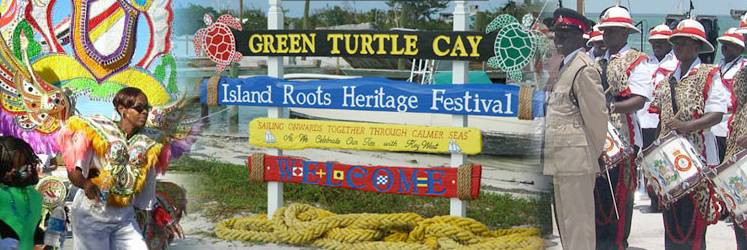
THE GREEN TURTLE HERITAGE FESTIVAL.
was started by renowned local artist Alton Lowe over decade ago - May 2004. Its inaugural event was intended to stimulate interest in "Sister City" revitalization between New Plymouth, Green Turtle Cay, and Key West, Florida. Another objective is to renew appreciation of Bahamian heritage and culture. hence the name change to the Island Roots Heritage Festival in '06. It's a grand celebration including performances by the Royal Bahamas Police Force Marching & Pop Bands, colorful Junkanoo parades, and an evening concert featuring the Key West Chorale. In addition, there is a festival site, which will provide food and drinks, kids' games, art & crafts, historic booths and all day fun and native entertainment. As the entire community is considered historic, a map outlining sites of interest, will be available for walking tours. Scores of Key West natives traditionally book accommodations in preparation for the celebrations.
The intent of the event, was to establish a "Sister City" concept between historic New Plymouth where the Loyalist first settled in 1784 and Key West, where many Green Turtle Cay residents relocated in the ensuing 150 years. There is presently a rich Bahamian heritage celebrated also in Key West, referred to commonly as the "Conch Republic" and where those of Abaconian ancestry have a similar keen interest in forging closer ties with Green Turtle Cay, Abaco and the Bahamas.
Since then, the festival has been growing annually and added and internet site including a "Schedule of Events" page which can be reached at
islandrootsheritagefestival.com. If you are planning a trip to the Abacos and more specifically Green Turtle Cay, in May, you might want to consider this event.
Eventually Man-O-War & Hope Town respectably got into the act each, with their own heritage festivals. For decades Green Turtle Cay has had their Albert Lowe Museum, Hope Town in the early 90's saw the opening of their Wyannie Malone Museum and as of 2011, Man-O-War opened their Heritage Museum and likewise started with their 1st annual Heritage Festival. For more info check their websites.
|
|


enlarge
TALES OF SALVAGE:
In the early days of these islands the native folks (loyalists that fled the revolution) supplemented their livelihood by wrecking, salvaging the cargo and gear from the ships often caught up on the many reefs that border these islands on the Atlantic side. One day the minister of the local church in Hope Town was giving his sermon when he looked out to sea and saw a boat heading for the reef. At a point in the service he asked everybody to close their eyes and bow their heads for a couple minutes of solemn meditation. At this point he removed his robe and headed out to the floundering ship as the first person on the scene has salvage rights. Naturally the congregation wasn't happy with their minister's actions and not only replaced him but passed a law that all churches would then have the seating arranged so the Ministers back would be to the sea. The church still stands today in Hope Town.
A more modern tale of salvage from the mid 1990's goes like this: Michael Malone of Marsh Harbour was diving about ten miles away at an old shipwreck near by at Lynard Cay. This is a place off the beaten track of the Florida cruising folks that pass by heading south. But it seems that only Mike knew of this particular ancient wreck told to him by his grandparents. Michael knew that this was an area where many boats met their doom. Most of the valuables had been picked over by generations of earlier Bahamians so he was surprised to find ingots, bullets and stone used as ballast in those old ships. Then to top his discovery he discovered a 2900 pound carronade, which is a short deck top cannon used in early times. He raised the cannon to the surface and brought home along with it's cannon balls. Once the sea growth was removed, he was surprised to see little deterioration of the metal despite being underwater for close to two century's. Further examination by scraping off it's black surface revealed it's true silver cast.
A similar situation applied to the cannon balls so he sent one of these to a metallurgist for analysis. Low and behold the cannon ball was made of an alloy consisting of 50% platinum! Later examination proved the cannon to contain 67% platinum. Tests performed by the British government sustained the claim. Further research determined it to be aboard the IRMELINDA a Scottish ship lost in the vicinity in 1811 and the gun to be made by Carron Ironworks of Sterling Scotland. Like most governments, The Bahamas lays claim to relics of this type found in its waters, in this case 25% of its value, which three different metallurgy laboratories was calculated to be 13 million dollars! By now we would expect Mr. Malone has received government approval to sell his cannon to a bona fide offer.
The above Carronade is similar to Malone's find. It is from Admiral Nelson's H.M.S. Victory, the world's oldest commissioned warship. Still manned by Officers and Ratings of the Royal Navy, the Victory has seen over 200 years of almost continuous service and best known for her role in the Battle of Trafalgar. It's berthed at Portsmouth, England and open to the public.

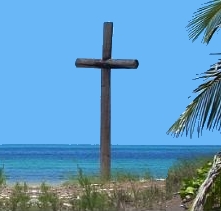
|
|
The CROSS of GREEN TURTLE On the northern tip of Green Turtle Cay, at the pass separating it from Fiddle Cay, lies the Cross of Green Turtle cay AKA The Thanksgiving Day Cross. How it came about makes for an interesting tale which is written about in our exclusive story.. |
__________________________________________
The Chinese are coming, The Chinese are coming,
A lot is happening in Abaco and the Bahamas in general regarding the Chinese.
We speak of large commercial port projects and economic entanglements and the close ties of the left leaning Bahamian government with the Chinese. The story is here.
|
|

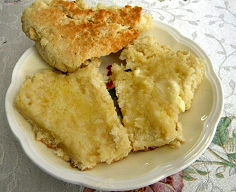 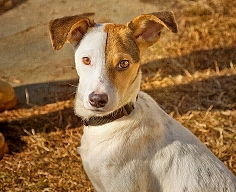
JOHNNY CAKE & POTCAKES.....
Two words you'll hear in the Abacos. Johnny Cakes - Often sung about, and often found in native restaurants in the Abacos and throughout the Caribbean for that matter. Johnny Cakes are bagel-sized biscuits made of corn meal and usually fried (sometimes called corn bread) . Legend has it that the name derives from "journey cake", meaning a bread that could be cooked ahead when going out to work or on a journey. For a Johnny Cake recipe click here.
Potcake - A "potcake" is the Bahamian term for the thick, congealed food that remains in the bottom of a pot of peas and rice after several reheatings. Traditionally, Bahamians feed potcake to the outdoor indigenous dogs that freely populate the Bahamas. Hence the dogs have come to be known as Potcakes. They have been sung about (Here) and even found their way on to postage stamps. Potcakes have been interbreeding for generations and have come, with the exception of color to look alike and have similar docile personalities. Some devotees consider them to be a breed all to themselves. 2014 was the year of the Potcake based on the amount of blogs and info posted.
See Video plus two really great blogs are here: A Dog’s Life: Potcakes at Sandy Point. and The Plight of the Bahamian Potcake.

CRACKER P. PINDER
AKA Paul John Simmons AKA the namesake of the bar of the same name on Lubbers Quarters. Cracker was born in 1879 and hailed from Lexington Ga. He was a veteran of the Spanish American War. His bayonet is mounted in the showcase of the bar bearing his name on Lubbers Quarters. In 1915 his family duck was terrorizing the neighborhood causing a fight between Cracker and sheriff Hickory Cartwright. In the ensuing struggle Cracker shot the sheriff and becoming a wanted man he fled to Florida. In time he caught a schooner to Wilson City (near Marsh Harbour). He disembarked, knowing this was to be his new home.
He worked his way to Hope Town, where he spent his first two years and met Mr. Lucene Pinder, Abacos commissioner. Eventually he took his name. It is said that Crackers family in Georgia sent funds “To Cracker” through Lucene. Later he settled on Lubbers Quarters where he fished and farmed. He planted many sapodilla trees, which is the fruit used in Bahamian Barbecue Sauce. Cracker built a continuously burning cooking fire which wasn't extinguished till he died in 1954.
Cracker had a limited wardrobe and therefore was the first naked person seen by the locals. Some locals say he had a small caliber rifle and was such a good shot that he could hit a fly on the top of the lighthouse. He would pole into town once a month for supplies. Folks would bring him meat in exchange for the vegetables he raised. He lead a truly reclusive life.
Cracker's gone now but his legend remains supported by two pictures and trinkets of his, in the bars showcase baring his name. The sweet sweet dilly - sapodilla trees still grow on the property where he lived, and where the bar now stands. Sitting on the porch you can see the remains of a pier he built with coconut trees towering over it. It's a pastime for local folks to have a drink in this lovely spot, while watching the unsuspecting sailboats run aground on the shoals in this part of Abaco Sound.
|
Manatees find a new home in the Abacos


Popular Links & Blogs








A Name you could hear twice in Abaco, and each would take on completely different meaning.
First is a phenomena of weather called the Abaco Rage. Its name pretty much conjures up something quite fierce, and you'd be correct. When conditions are right, storms often miles off shore from Abaco and often nowhere in sight, produce large ocean swells. As the westward headed swells approach the abrupt shallows of the Sea of Abaco, they "swell up" to 3 times their original height and also compress the distance between them. This phenomena is especially prevalent at the passages between the cays. One place of renowned is the Whale Cay Passage. This spot is notorious because the shallows behind the cay prevent large craft from passing even in normal conditions forcing them out into the ocean and back into the Sea of Abaco on the other side. When a full blown rage is present, any attempt of passage could be suicide and to pass with even small outboard type craft on an inside passage is also dangerous because the rollers can lift the boat upwards only to have it come crashing down on to the shallow sand bar behind Whale Cay, reeking havoc on running gear and even ones hull. It is an area to be avoided in such conditions. Just the same, and the south end of Whale Cay in an area known as Bakers Bay, Disney would moor their Red cruise ships and tender folks to their "Out Island Home" on Guana Cay. It didn't take long for Disney to realize their mistake, having to deal with often treacherous anchoring conditions in the area and pulled anchor for good and moved their island sanctuary to Gorda Cay, now called Castaway Island. There is many a tale to be told of vessels of all types meeting their doom in the "Infamous Whale Cay Passage".

|
|
From the log of the Motu Iti
Motu Iti - 34' Catilina Islander (flybridge) 1997: We were off to Green Turtle for our return trip home. The wind was about half the day before (10-15 knots). The swells in the Whale Cay Passage hadn't subsided yet and were in the 10 - 12 foot range and generally not breaking. For the most part they'd be abeam of us until we turned back in from the ocean making for a hell of a roller coaster ride. I decided to shorten the trip and cut a corner in the plotted course which took me into the shallower water near Whale, 20 feet instead of 50. At some point my wife said "don't look back". So, naturally I did, and saw a wave breaking behind us - Yikes! Well, we made it without incident. Our traveling companions made it through OK also. This passage was only 15 minutes of the 1 hour and 15 minute trip from M-O-W to G.T. Gotta say though, it was exhilarating. We arrived at the Green Turtle Club Marina and was assigned our slip assignment.
|
- - - - The Abaco Rage - The Man-O-War Built Sloop - - -
But before The Rage was........
Tidal Wave captained by Rolly Gray who won the first Family Island Regata in 1954. Rolly died in 2007 a national hero with commemorative statues erected for him. Even songs about him have been written. Here is '04 Documentary Video
with vintage footage - a must see. Includes a HiDef music tribute to Rolly.
The Bahamas Out Island Regatta Time
(Regatta Time Video)
A Rage For Glory
The Comeback of an Abaco Champ
An AbacoLife Archive by
By Jim Kerr Editor
The mood on the harbour veranda of Capn' Jack's Restaurant in Hope Town was bright as the late afternoon sun setting behind the lighthouse. A dozen men - and one woman - gathered around hastily drawn together tables, but despite the serious strategic nature of this business meeting, the talk was animated, cheerful and optimistic.
It was the same sort of giddy ebullience that had swept this crew of the Abaco Rage as the freshly painted and refitted sloop crossed the finish line of the 45th annual National Family Island Regatta in Exuma only a month earlier. For despite finishing the race in last place, it had been a great comeback; a revival worthy of enormous pride and enthusiasm for the future. It was the return of a champion, a resurrection - and definitely the beginning of a new era.
For seven years, the Abaco Rage, a Class A sloop built in 1980 on Man-O-War Cay, had languished unattended and unraced. In her earlier days she had been the boat to beat, having won the Out Island Regatta in Exuma two years in a row in 1983 and 1984. But after placing second overall in 1990, her owners had parked her in retirement at Man-O-War, a victim of rising costs and falling enthusiasm for the rigors and demands of the distant regatta in far off George Town, Exuma
In October, 1997, a consortium of new owners emerged from Hope Town. Fund raisers were held. Repairs were made. Materials were scrounged. It was time to re-enter this time-honored sailing contest and regain rightful recognition for this island community, once the bastion of wreck salvagers, blockade runners and boat builders extraordinaire.
"Three quarters of the deck and all of the cockpit was rotten," said Ron Engle, supervisor of the reconstruction. "Bulkheads and ribs were replaced as well as all running and standing rigging. The boat was stripped to the wood and repainted from the keel up."
One new pry bar had to be replaced. Decks were framed, fiber-glassed and sealed. Initial work cost more than $7,000 and was finished in only 18 days so the Rage could compete in the newly established All Abaco regatta in November. It was a giant, around-the-clock effort, and she did moderately well, placing seventh and fifth in two races. For the looming Exuma contest, new canvas sails were ordered from Nassau. But, despite promises of delivery in four days, it took almost four months to get them. By then it was April, and the Rage was under tow to Exuma. The untried sails were picked up only a week before the big event, but there was more troubled water ahead. Nature's rage at sea swept the party, breaking the rudder on the man-made Rage. Fifteen people worked in shifts around the clock making repairs as the crew camped on a small cay in the Exumas. The boat finally arrived in George Town one day before the first race, but what they found was heartening - a welcoming reception that translated into much pre-race help from competitors.
Once the starting cannon fired, however, they were on their own - with more problems. It was discovered the new sails were incorrectly cut. And by the final Class A event on the last day of racing, the inexperienced crew and troubled craft had accumulated only four total points, putting them dead last. Learning curve corrections helped garner another five points in the last big race, putting them in a tie for seventh out of eight starters.
Now, in this early evening meeting at Capn' Jack's, the crew of the 28-foot native sloop pondered the problems, heads together in the last strategy session on the eve of another major journey and contest, this time almost 300 miles away in Long Island. It would be no picnic this time either. Crew members were assigned, travel plans made, costs considered. Some would fly while others would endure a three-day transit by mailboat. The crew would number as many as 15 people, including Rhiannon Gottleib of Hope Town, the first woman crew member ever to race in the Exuma and Long Island Regattas.
The boat itself, left behind in George Town after the April event, was towed by Long Islanders to Salt Pond for her first appearance ever in that colourful series.
"They were delighted to have us," said co-captain Jeff Gale. "They even loaned us sails, which made a big difference." Again, friendly comraderie and assistance ended at the starting line as the cannon sounded the one-minute warning, then the start. Anyone who has seen this knows the dramatic drill. From dead in the water with anchors down, competing sloops simultaneously hoist hooks and raise sails. It appears to be a mad scramble as the crew pulls frantically on lines, but the effort is timed so that anchors and sails are raised in coordination. Each boat hopes to catch the first breath of wind, perhaps to break from the line and steal the breeze from a competitor.
Strict rules govern the races. Competing boats must be designed, built, owned, skippered and crewed by Bahamians. Overall length must be 28 feet, three inches or less. Sails must be canvas with a single mast. Hull and mast must be wood. No vertical transoms. No bowsprits. No spreaders or aluminum spars. No winches. No wind or speed instruments or tell-tales. No bending masts.
The boats sail three times around orange buoys placed at each corner of a triangular course. Running with the wind, they list at incredible angles. To balance and maximize speed, depending on wind direction and strength, as many as nine crew members climb precariously onto three "prys," wooden planks that can be extended out about four feet to either starboard or port. A boat that does not stop for someone falling overboard is disqualified. It rarely happens, but when it does, the unlucky lout is fished from the sea in the bat of an eye. The captain usually mans the helm, but just as important is the bowman who yells commands. Everyone knows his - and her - job, and human coordination with nature is the key. In the end, experience here is everything.
When Scott Weatherford of Man-O-War captained the Abaco Rage to two straight victories in the mid 1980s, he had a seasoned crew. Many had raced in previous contests in the 1970s aboard two other sloops, Man-O-War and Rough Waters. By then, Scott and others were hooked on racing and were determined to win. Volunteers at Edwin's Boat Yard on Man-O-War worked Saturdays and nights for six months building Abaco Rage, each man hoping for a chance to sail on her in George Town.
|
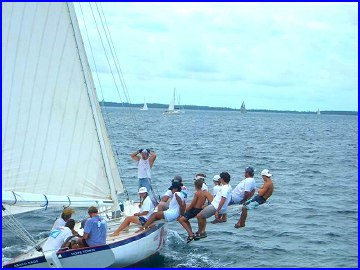
Paintings by Abaconian Artist
Bob Zwickel
Abaco Rage
Links to Bob and other Bahamian Artists
Can be found at
AbacoArtists.com
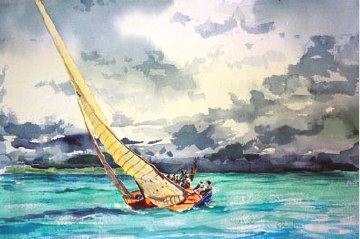
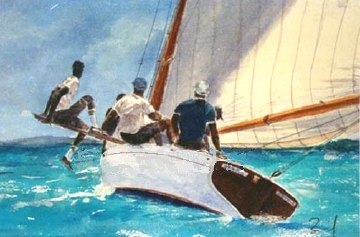
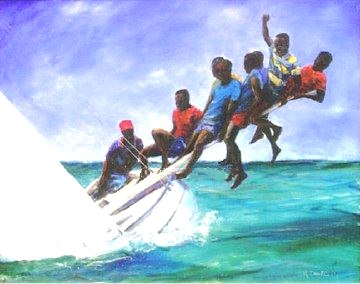
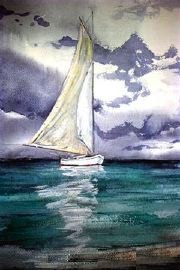 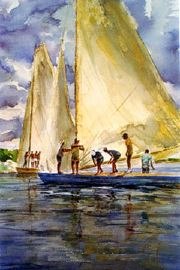
In 1984, Abaco Rage won first place hands down with Man-O-War close behind in third. Abaco sloops, which had not even participated in the Exuma event during its first 21 years, now dominated it.
After some controversy and two second-place wins in 1987 and 1990, however, the Man-O-War team decided to call it quits. And although the languishing champ sat rotting from lack of use and maintainance, it was not without some reluctance that she was sold to Hope Towners. Trial and error has resulted in improvements ever since, and the crew now has three races under its collective belt.
"More lessons were learned in Long Island," remarked skipper Jeff Gale. "We need to deepen the keel by a foot, smooth out the bottom and make it super slick - and get new sails."
The next race - the All Abaco Regatta, scheduled for October between the Treasure Cay Ferry Dock and Green Turtle Cay - is not far off, and George Town is a scant six months after that. By all indications, Abaco Rage and her spirited crew will be ready. More: Abaco Journal Article.
Regatta Time Organizers
Abaco Rage on Boxing Day 2015 (Video)
Past Regatta Time Video
|
|

Guy Fawkes Holiday.
|
Who was
Guy Fawkes?
============
Ladies and gentlemen you'll never grow fat,
If you don't put a penny in the old Guy's hat,
Guy, Guy, Guy!
Stick him up on high;
Hang him on a lamp post and leave him there to die.

Remember, remember
the fifth of November,
Gunpowder treason and plot.
We see no reason
Why gunpowder treason
Should ever be forgot!
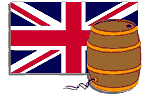
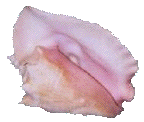
All About Conch
|
|
Celebrated in the Bahamas around November 5th, is the Hanging of Guy Fawkes. It's a cary over form the days when the Bahamas were a British Colony. So who is Guy Fawkes you ask?
Guy Fawkes, the most infamous conspirator of the "Gunpowder Plot", was a tall athletic man with brown hair and auburn beard, modest, self contained and valiant. In 1595 Guy Fawkes was present at the capture of Calais by the Spaniards and accordingly "was sought and admired by all the most distinguished in the camp for his nobility and virtue".
On the death of Elizabeth, Fawkes and Christopher Wright visited Philip III of Spain with a view to securing relief for their Catholic countrymen as James I, the Scottish king and Successor to Queen Elizabeth, turned out to be no less tolerant of the Catholics.
As a result Fawkes was selected to join the "Gunpowder Plot" by Robert Catesby on account of his military qualities and his face being unknown to the Government spies. They devised a plan to blow up the Houses of Parliament killing the King, possibly the Prince of Wales, and the Members of Parliament presumably in the belief that they would be replaced by a new monarch who might be more sympathetic to the Catholic cause. This they attempted to do in 1605.
The conspirators stored 36 barrels (almost 2 tons) of gunpowder, covered by iron bars and firewood, in a cellar hired by one of the group, just under the House of Lords. On 26th October, however, William Parker, 4th Baron Monteagle received an anonymous letter warning him not to attend the opening of parliament on November 5th. Hearing this, the conspirators were concerned that their plot had been discovered. However the information received by them over the following days convinced them that it was safe to continue with their plans.
In the early hours of November 5th the authorities stormed the cellar and found Guy Fawkes with the 36 barrels of gunpowder. He was immediately arrested and subsequently held captive in the Tower of London where he was tortured to reveal the names of his co-conspirators.
They were tried for high treason in Westminster Hall on 27th January 1606 and all were convicted and sentenced to death. The executions took place on 30th and 31st January, Fawkes being executed on the second day. All the conspirators were hanged, drawn and quartered which was the customary method of execution for traitors. Their heads and other parts of their bodies were displayed at various points around Westminster and London.
The occasion of that event is still celebrated in many past and present British colonies today including the Bahamas with appropriately fireworks, bonefires and other festivities. If you plan to be there over November 5th, check around you might happen upon such an event.
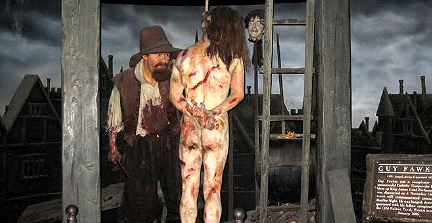
|
|



